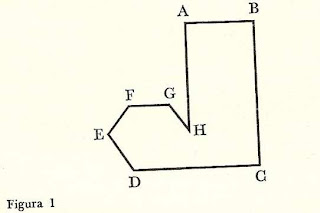THE DIVISION OF THE PERCEIVED UNIVERSE INTO PORTS AND WHOLE IS CONVENIENT AND MAY BE NECESSARY, BUT NO NECESSITY DETERMINES HOW IT SHALL BE DONE
I have tried many times to reach this generality to classes of students and for this purpose have used Figure 1.

The figure is presented to the class as a reasonably accurate chalk drawing on the blackboard, but without the letters marking the various angles. The class is asked to describe "it" in a page of written English. When each student has finished his or her description, we compare the results. They fall into several categories:
a. About 10 percent or less of students say, for example, that the object is a boot or more picturesquely, the boot of a man with a gouty toe or even a toilet.
Evidently, from this and similar analogic or iconic descriptions, it would be difficult for the hearer of the description to reproduce the object.
b. A much larger number of students see the object contains most of a rectangle and most of a hexagon, and having divided it into parts in this way, then devote themselves to trying to describe the relations between the incomplete rectangle and hexagon. A small number of these (but, surprisingly, usually one or two in every class) discover that a line, BH, can be drawn and extended to cut the base line, DC, at a point I in such a way that HI will complete a regular hexagon (Figure 2).

This imaginary line will define the proportions of the rectangle but not, of course, the absolute lengths. I usually congratulate these students on their ability to create what resembles many scientific hypotheses, which "explain" a perceptible regularity in terms of some entity created by the imagination.
c. Many well-trained students resort to an operational method of description. They will start from some point on the outline of the object (interestingly enough, always an angle) and proceed from there, usually clockwise, with instructions for drawing the object.
d. There are also two other well-known ways of description that no students has yet followed.
No student has started from the statement "It’s made of chalk and blackboard." No student has ever used the method of the halftone block, dividing the surface of the blackboard into grid (arbitrarily rectangular) and reporting "yes" and "no" on whether each box of the grid contains or does not contain some part of the object. Of course, if the grid is coarse and the object small, a very large amount of information will be lost. (Imagine the case in which the entire object is smaller than the grid unit. The description will then consist of not more than four or less than one affirmation, according to how the divisions of the grid fall upon the object.) However, this is, in principle, how the halftone blocks of newspaper illustration are transmitted by electric impulse and, indeed, how television works.
Note that all these methods of description contribute nothing to an explanation of the object-the hexago-rectangle. Explanation must always grow out of description, but the description from which it grows will always necessarily contain arbitrary characteristics such as those exemplified here.


Metalogue
Daughter. Daddy, why do things have outlines?
Father. Really? I do not know. What things do you speak?
D. Yes, when I draw things, because they have outlines?
F. Well, and other things ... a flock of sheep? Or a conversation? These things have outlines?
D. Do not be silly. You can not draw a conversation. I say things.
F. Yes ... I was just trying to understand what you meant.
You mean: "Because when we give them things we draw the boundaries?" Or do you mean that things have contours, which draw us or not?
D. I do not know, Dad, you must tell me. What I want to ask?
































